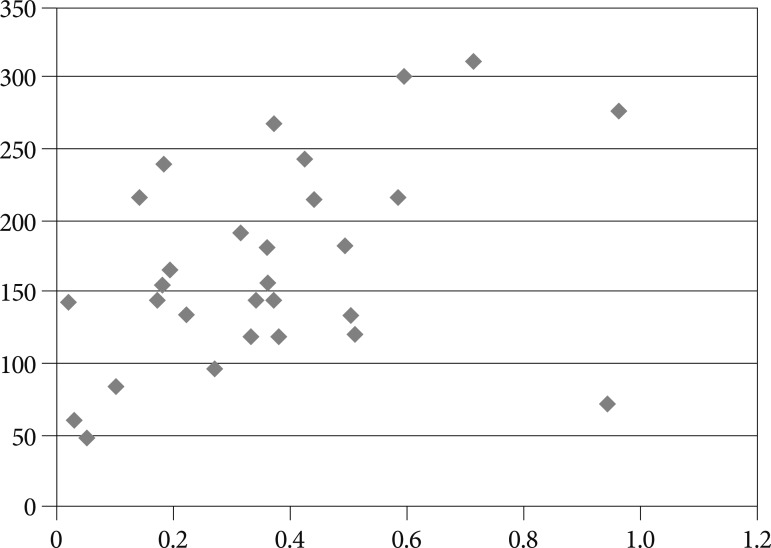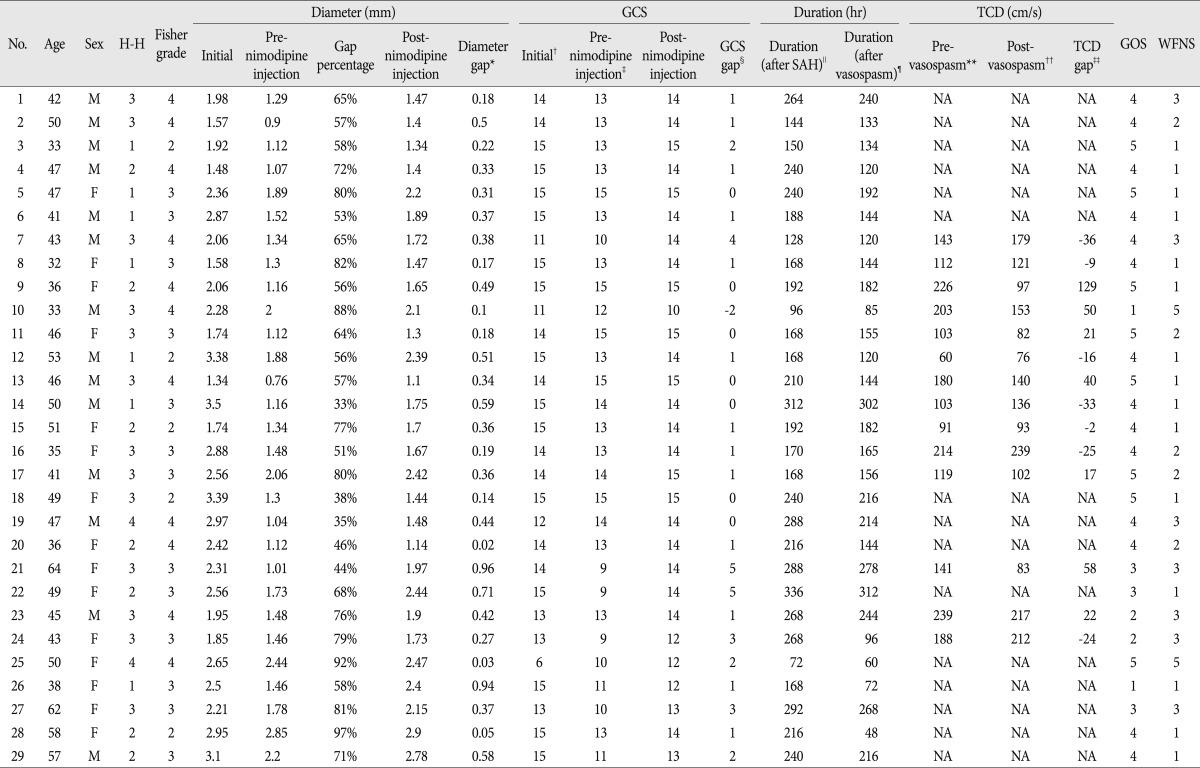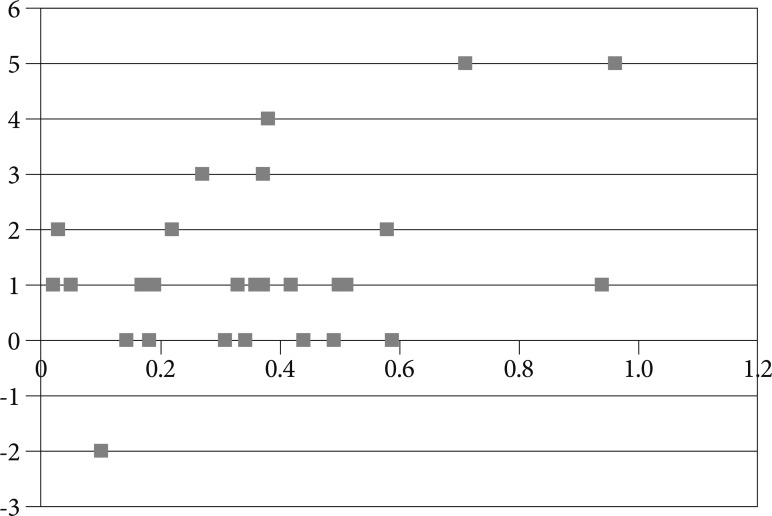1. Biondi A, Ricciardi GK, Puybasset L, Abdennour L, Longo M, Chiras J, et al. Intra-arterial nimodipine for the treatment of symptomatic cerebral vasospasm after aneurysmal subarachnoid hemorrhage : preliminary results. AJNR Am J Neuroradiol. 2004; 25:1067–1076. PMID:
15205150.
2. Böker DK, Solymosi L, Wassmann H. Immediate postangiographic intraarterial treatment of cerebral vasospasm after subarachnoid hemorrhage with nimodipine. Report on 3 cases. Neurochirurgia (Stuttg). 1985; 28(Suppl 1):118–120. PMID:
4010867.

3. Bracard S, Arrue P, Barral FG, Bouquigny F, Berge J, Bonneville J, et al. [Management of vasospasm from subarachnoid hemorrhage. Attitude of French centers. French Society of Neuroradiology]. J Neuroradiol. 1999; 26:S44–S47. PMID:
10363452.
4. Broderick JP, Brott TG, Duldner JE, Tomsick T, Leach A. Initial and recurrent bleeding are the major causes of death following subarachnoid hemorrhage. Stroke. 1994; 25:1342–1347. PMID:
8023347.

5. Chou SH, Smith EE, Badjatia N, Nogueira RG, Sims JR 2nd, Ogilvy CS, et al. A randomized, double-blind, placebo-controlled pilot study of simvastatin in aneurysmal subarachnoid hemorrhage. Stroke. 2008; 39:2891–2893. PMID:
18658043.

6. Clouston JE, Numaguchi Y, Zoarski GH, Aldrich EF, Simard JM, Zitnay KM. Intraarterial papaverine infusion for cerebral vasospasm after subarachnoid hemorrhage. AJNR Am J Neuroradiol. 1995; 16:27–38. PMID:
7900600.
7. Dion JE, Duckwiler GR, Viñuela F, Martin N, Bentson J. Pre-operative micro-angioplasty of refractory vasospasm secondary to subarachnoid hemorrhage. Neuroradiology. 1990; 32:232–236. PMID:
2145526.

8. Elliott JP, Newell DW, Lam DJ, Eskridge JM, Douville CM, Le Roux PD, et al. Comparison of balloon angioplasty and papaverine infusion for the treatment of vasospasm following aneurysmal subarachnoid hemorrhage. J Neurosurg. 1998; 88:277–284. PMID:
9452236.

9. Findlay JM, Macdonald RL, Weir BK. Current concepts of pathophysiology and management of cerebral vasospasm following aneurysmal subarachnoid hemorrhage. Cerebrovasc Brain Metab Rev. 1991; 3:336–361. PMID:
1772740.
10. Grotenhuis JA, Bettag W, Fiebach BJ, Dabir K. Intracarotid slow bolus injection of nimodipine during angiography for treatment of cerebral vasospasm after SAH. A preliminary report. J Neurosurg. 1984; 61:231–240. PMID:
6737047.

11. Hui C, Lau KP. Efficacy of intra-arterial nimodipine in the treatment of cerebral vasospasm complicating subarachnoid haemorrhage. Clin Radiol. 2005; 60:1030–1036. PMID:
16124986.

12. Kassell NF, Helm G, Simmons N, Phillips CD, Cail WS. Treatment of cerebral vasospasm with intra-arterial papaverine. J Neurosurg. 1992; 77:848–852. PMID:
1432125.

13. Leeds NE, Taveras JM. Changes in local circulation time in frontal and parietal tumours studied by rapid serial angiography. Acta Radiol (Diagn). 1963; 1:332–342.

14. Livingston K, Guterman LR, Hopkins LN. Intraarterial papaverine as an adjunct to transluminal angioplasty for vasospasm induced by subarachnoid hemorrhage. AJNR Am J Neuroradiol. 1993; 14:346–347. PMID:
8456709.
15. Mathis JM, DeNardo AJ, Thibault L, Jensen ME, Savory J, Dion JE. In vitro evaluation of papaverine hydrochloride incompatibilities : a simulation of intraarterial infusion for cerebral vasospasm. AJNR Am J Neuroradiol. 1994; 15:1665–1670. PMID:
7847210.
16. Meyer FB. Calcium antagonists and vasospasm. Neurosurg Clin N Am. 1990; 1:367–376. PMID:
2136149.

17. Numaguchi Y, Zoarski GH, Clouston JE, Zagardo MT, Simard JM, Aldrich EF, et al. Repeat intra-arterial papaverine for recurrent cerebral vasospasm after subarachnoid haemorrhage. Neuroradiology. 1997; 39:751–759. PMID:
9351116.

18. Pickard JD, Walker V, Vile J, Perry S, Smythe PJ, Hunt R. Oral nimodipine reduces prostaglandin and thromboxane production by arteries chronically exposed to a periarterial haematoma and the antifibrinolytic agent tranexamic acid. J Neurol Neurosurg Psychiatry. 1987; 50:727–731. PMID:
3475405.

19. Polin RS, Coenen VA, Hansen CA, Shin P, Baskaya MK, Nanda A, et al. Efficacy of transluminal angioplasty for the management of symptomatic cerebral vasospasm following aneurysmal subarachnoid hemorrhage. J Neurosurg. 2000; 92:284–290. PMID:
10659016.

20. Polin RS, Hansen CA, German P, Chadduck JB, Kassell NF. Intra-arterially administered papaverine for the treatment of symptomatic cerebral vasospasm. Neurosurgery. 1998; 42:1256–1264. discussion 1264-1267. PMID:
9632183.

21. Rasmussen G, Bergholdt B, Dalh B, Sunde N, Cold G, Voldby B. Effect of nimodipine on cerebral blood flow and cerebrovascular reactivity after subarachnoid haemorrhage. Acta Neurol Scand. 1999; 99:182–186. PMID:
10100962.

22. Rinkel GJ, Feigin VL, Algra A, van Gijn J. Circulatory volume expansion therapy for aneurysmal subarachnoid haemorrhage. Cochrane Database Syst Rev. 2004; CD000483. PMID:
15494997.

23. Roda JM, Carceller F, Díez-Tejedor E, Avendaño C. Reduction of infarct size by intra-arterial nimodipine administered at reperfusion in a rat model of partially reversible brain focal ischemia. Stroke. 1995; 26:1888–1892. PMID:
7570744.

24. Rosenwasser RH, Armonda RA, Thomas JE, Benitez RP, Gannon PM, Harrop J. Therapeutic modalities for the management of cerebral vasospasm : timing of endovascular options. Neurosurgery. 1999; 44:975–979. discussion 979-980. PMID:
10232530.

25. Schuknecht B, Fandino J, Yüksel C, Yonekawa Y, Valavanis A. Endovascular treatment of cerebral vasospasm : assessment of treatment effect by cerebral angiography and transcranial colour Doppler sonography. Neuroradiology. 1999; 41:453–462. PMID:
10426225.

26. Song JK, Elliott JP, Eskridge JM. Neuroradiologic diagnosis and treatment of vasospasm. Neuroimaging Clin N Am. 1997; 7:819–835. PMID:
9336501.
27. Vajkoczy P, Horn P, Bauhuf C, Munch E, Hubner U, Ing D, et al. Effect of intra-arterial papaverine on regional cerebral blood flow in hemodynamically relevant cerebral vasospasm. Stroke. 2001; 32:498–505. PMID:
11157189.









 PDF
PDF ePub
ePub Citation
Citation Print
Print




 XML Download
XML Download